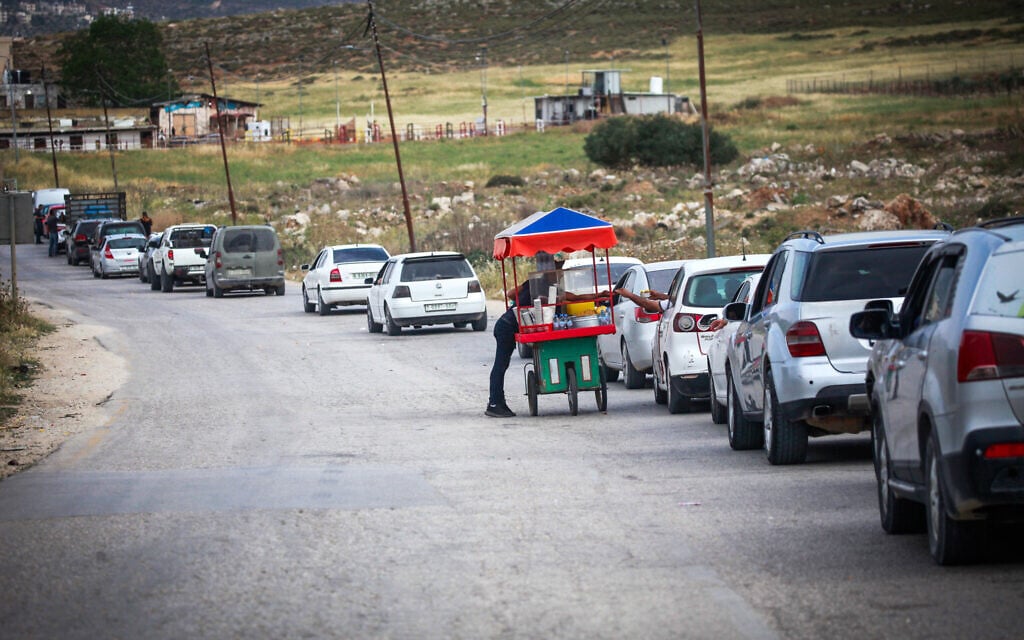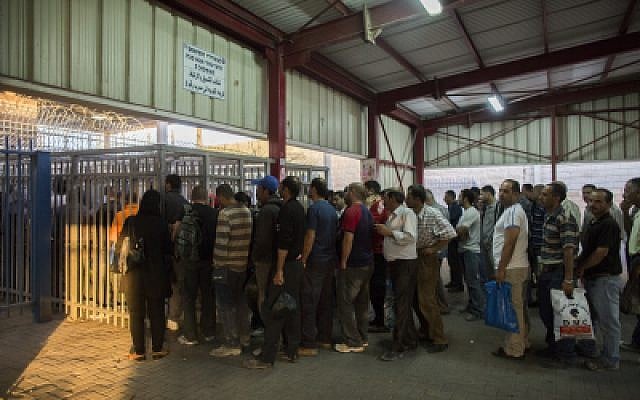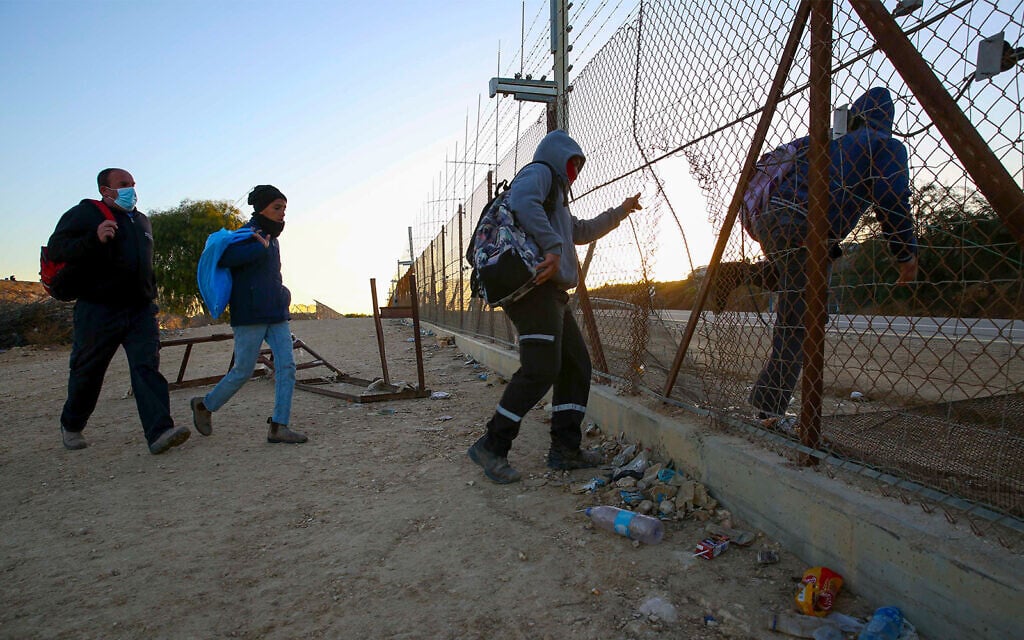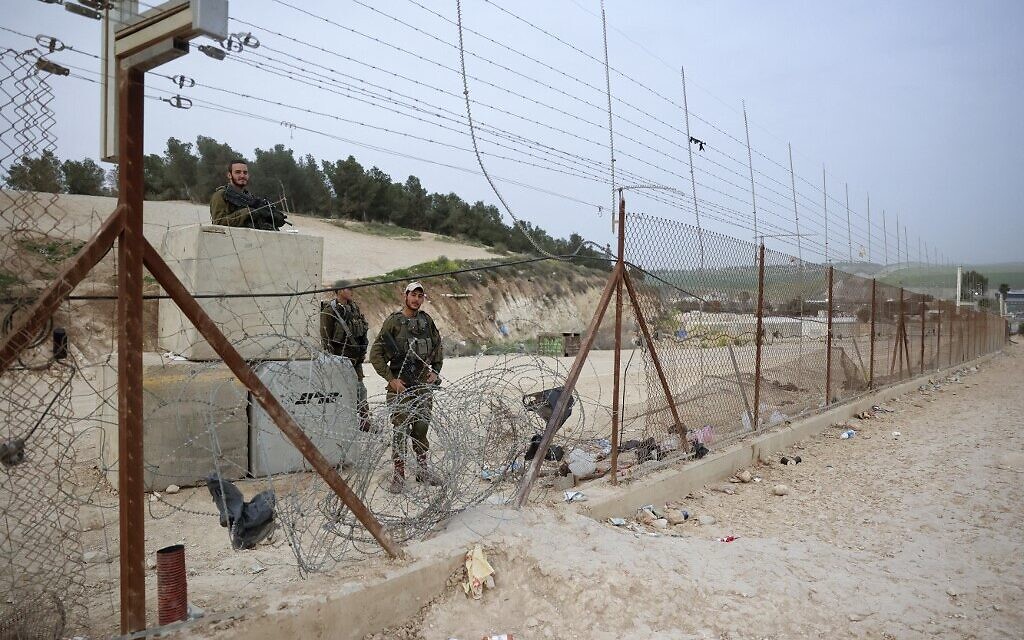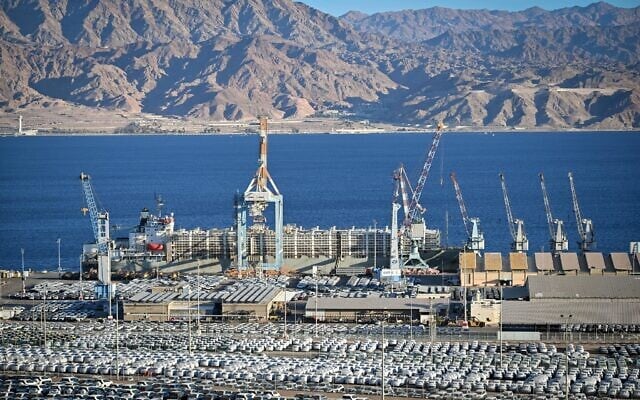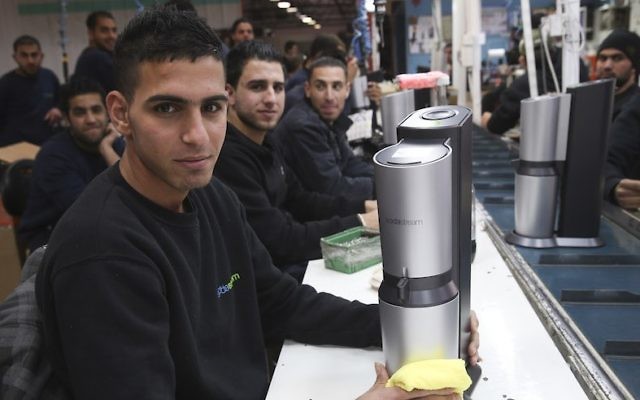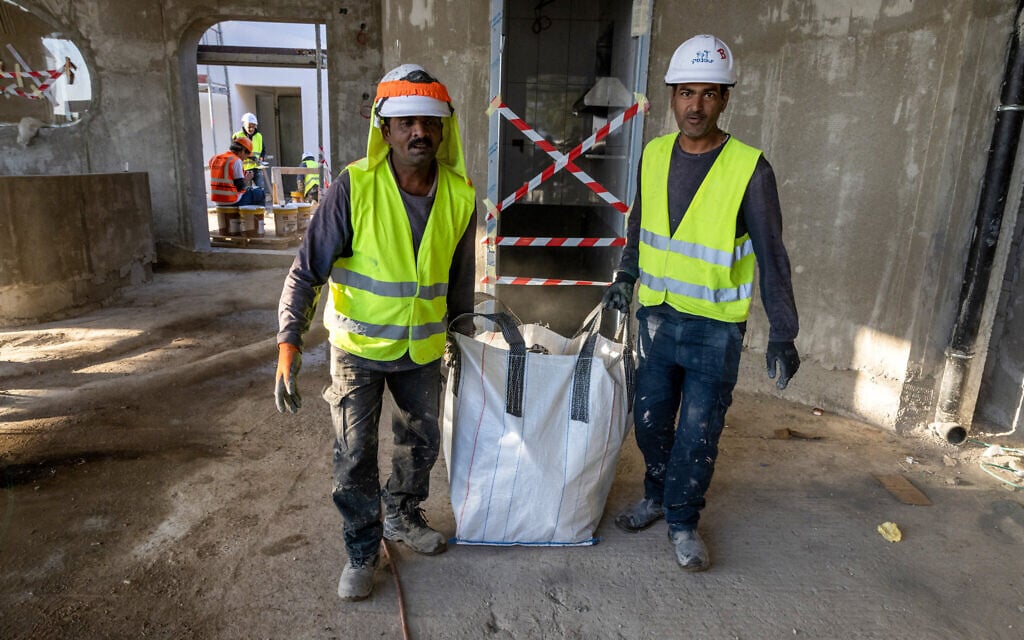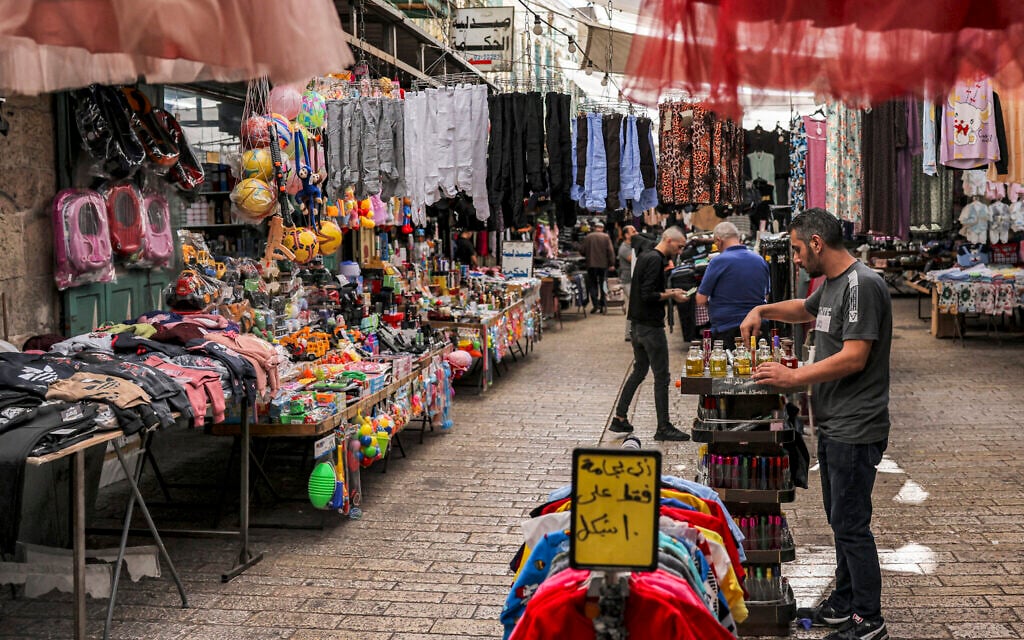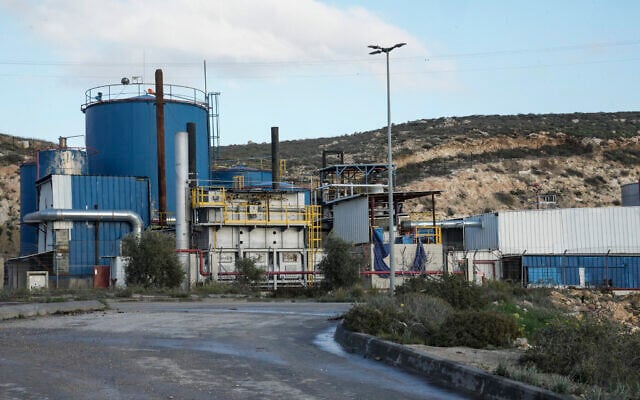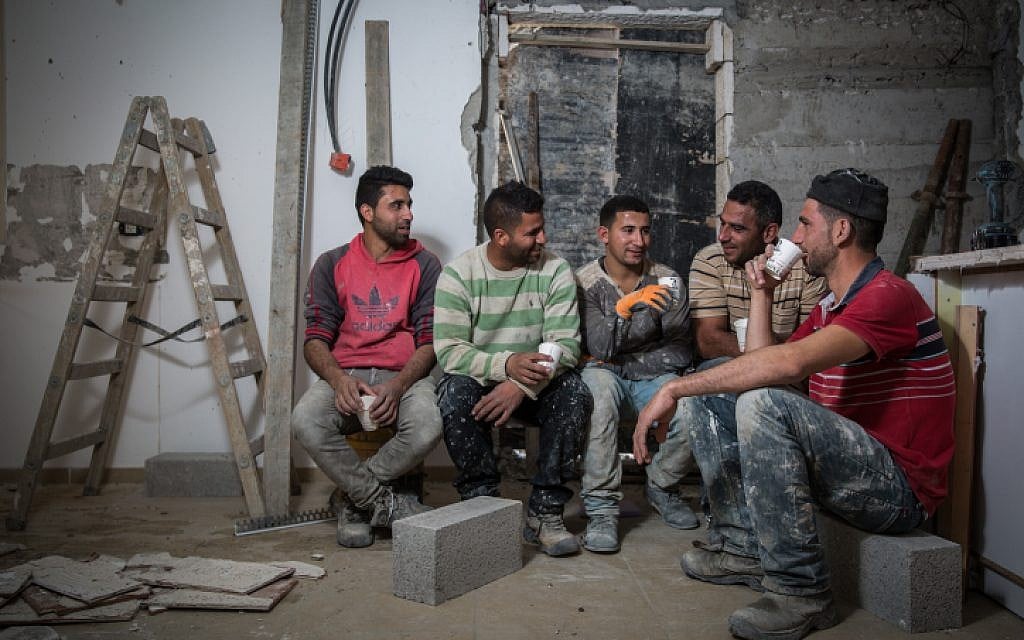


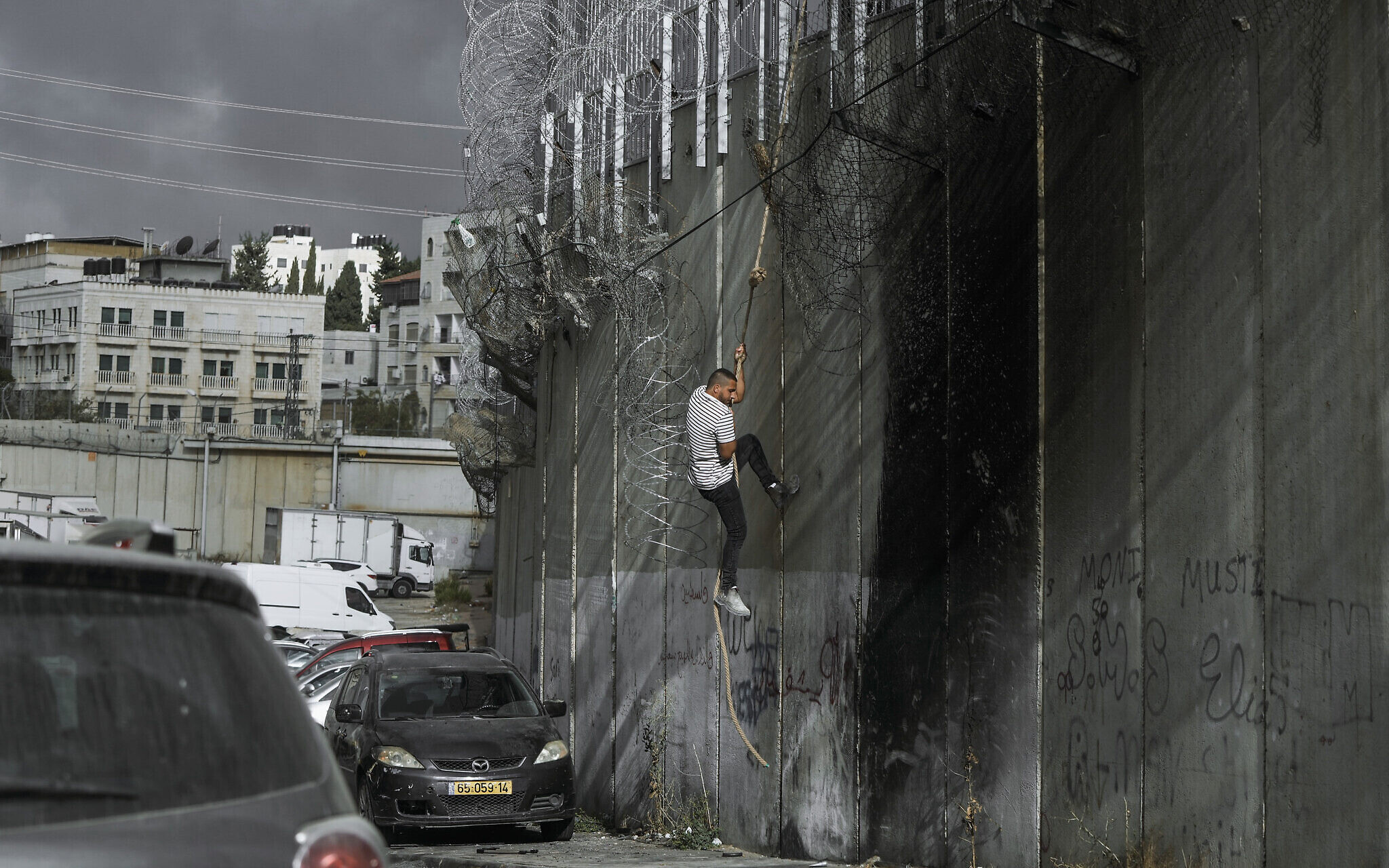
For 30 years, Mohammad Abu Zahra, a Palestinian from the southern West Bank, worked in construction in Israel. It was a relatively well-paying job that brought in a far higher salary than similar labor did in the West Bank.
Then, on October 7, 2023, the work stopped. As part of its response to the Hamas-led invasion from Gaza, Israel sharply restricted the entry of West Bank Palestinian workers, a step that carried severe consequences for the approximately 2 million Palestinians living there.
More than 21 months into the war, the number of permits has not bounced back. Perhaps most significantly, Israel banned Palestinian workers from the construction industry — by far their largest labor sector in Israel.
“How do we get by? Only God knows,” Abu Zahra told The Times of Israel. “There’s no income at all — zero. I haven’t worked in two years. We sold our gold, sold construction equipment, borrowed from friends, wrote postdated checks.”
The steep reduction in permits, which was never formally explained by the government, is believed to be predicated on security concerns after thousands of Palestinians streaming across the Gaza border carried out massacres in Israeli communities on October 7.
The October 7 attack reinvigorated distrust in Palestinians for many Israelis, which was coupled with suspicions that Gazans who had entered Israel in the past had provided intelligence to attackers regarding the communities they had worked in.
But the decision to severely limit permits marked a change: In the past, defense officials had insisted on keeping them in place even after attacks originating in the West Bank. Indeed, terror incidents involving Palestinians with permits to work in Israel, who must undergo an intensive Shin Bet vetting process, have been exceedingly rare.
At the same time, small numbers of West Bank Palestinians without permits have continued to find their way into Israel, whether to work or carry out attacks — or sometimes both. The assailants in a fatal January 2024 attack in Ra’anana had been working illegally in Israel in the period leading up to the rampage, and that attack is just one of several acts of terrorism inside Israel committed by Palestinians from the West Bank during the Gaza War, despite heavy IDF deployment there.
For the vast majority of Palestinians in the West Bank, who want to work but have no interest in terrorism, the permit cut has amounted to an ongoing punishment for a war they did not start and are not fighting.
“There is deep distress, not just from the loss of income, but from the emotional toll,” said Assaf Adiv, head of the Israeli-Palestinian labor rights group Ma’an, which represents Palestinian workers employed by Israelis in both Israel and the West Bank.
Adiv said he hears daily from those affected by the policy.
‘These are people who were used to supporting their families, who were sending their kids to university, and now have to pull them out’
“These are people who were used to supporting their families, who were sending their kids to university, and now have to pull them out,” he added. “We’re not just talking about nuclear families — these workers earned above-average incomes and supported extended family.”
“They can’t even buy food, let alone gifts,” he said. “It’s incredibly frustrating.”
Before the war, roughly 100,000 West Bank Palestinians worked inside Israel, and another 40,000 were employed in Israeli settlements and Israeli-controlled industrial zones in the West Bank.
Today, that number has shrunk to just 11 percent of what it was before October 7. In Israel, only around 7,000 Palestinians are allowed to enter each month, all classified as essential workers in sectors such as hospitality or food manufacturing. Another 9,000 work in settlements or nearby industrial zones.
The effect has been especially in construction. According to the Defense Ministry’s Civil Administration, which manages civilian affairs in the West Bank, 90% of Palestinians working in Israel before the war were employed in construction. Data presented by the Finance Ministry in January 2024 showed that Palestinians made up 29% of Israel’s construction workforce before October 7.
Because the Palestinian economy in the West Bank is so much smaller than Israel’s, similar jobs are hard to come by locally. And Israeli jobs pay much better.
The average monthly salary in the West Bank is about NIS 1,431 (roughly $430). By contrast, Israel’s minimum wage, which applies to legal Palestinian workers, is more than quadruple, at NIS 6,247 (about $1,890). Skilled Palestinian construction workers can earn NIS 8,000 (about $2,380) or more per month.
One Palestinian, who asked not to be named for his own privacy, worked for a major Israeli construction firm for 13 years before being barred from entry after October 7.
“I haven’t worked in two years,” he told The Times of Israel. “When I stopped working after October 7, I withdrew my pension and used it to make a down payment on a house — but it’s just a shell now. I ran out of money. I’m renting and drowning in debt.”
Another former worker who wished to remain anonymous told The Times of Israel that he was forced to pull one of his sons out of university and move his 11-year-old from a private school to a public one due to a lack of funds.
The hardship has pushed many Palestinians to take risks and enter Israel illegally to find work, sneaking through openings in the West Bank security barrier, hiding in vehicles, or purchasing forged medical permits that allow their holder to enter Israel. While such practices existed before, the number of unauthorized entries has spiked dramatically in recent months.
Israel’s security services estimate that since the post-October 7 permit cut, around 40,000 Palestinians per month are entering Israel illegally to work, twice the prewar figure. These workers are typically paid in cash, often under the table, and lack the legal and regulatory protections afforded to other employees.
A May report from the Palestinian Central Bureau of Statistics, which, unlike its Israeli counterpart, also accounts for illegal employment, found that 18,200 Palestinians are working without permits inside Israel or in West Bank areas under Israeli control.
For many, the higher wages make such jobs worth the risk.
‘I went to Israel for 20 straight days, then returned home for two or three months, then went back again when the debts piled up’
One such worker, who asked to remain anonymous for his safety, told The Times of Israel that he had entered Israel illegally seven times over the past two years. With the Israeli income, he can support his family as well as relatives who work for the Palestinian Authority, which has cut salaries due to its own financial woes.
“I went to Israel for 20 straight days, then returned home for two or three months, then went back again when the debts piled up,” he said. “The last time I went was in March. If things get worse and I can’t bring home food, I’ll go again. A man risks his life to feed his family.”
To cross the border, he either pays for a permit on the black market or sneaks through a hole in the fence. The maneuvers, he said, risk arrest or worse.
“I was terrified that I’d be in a car accident, or that I’d be caught,” he said. “Getting caught would be the best-case scenario. A soldier at the fence could shoot me. But if my child is sitting at home, hungry, and asking me for food — that’s a disaster. I can’t live with that.”
Despite the economic shock, financial ties between Israel and the West Bank have proven remarkably stable. Before the war, according to 2022 data from Israel’s Central Bureau of Statistics, Palestinian areas were the country’s third-largest export market.
That stability was not inevitable. During the Second Intifada, from 2000 to 2005, large-scale violence in the West Bank and Israel led to a collapse in trade volume between Israelis and Palestinians. It took four years for Palestinian exports to return to pre-intifada levels, and two more years for imports to do so.
During the current conflict, Palestinian inflation has remained relatively low, and the volume of trade between Israel and the West Bank, including both imports and exports, has remained at prewar levels.
Goods from Israel have hovered between 55% and 60% of Palestinian imports over the past two years, according to official statistics. Israeli exports to the West Bank fell by 30% in late 2023, immediately after October 7, but mostly recovered within six months. By mid-2024, they were just 15% below prewar levels.
Figures from the Palestinian Central Bureau of Statistics also reflect a heavy dependency on Israel: In 2024, 87% of all declared Palestinian exports went to Israel or were exported abroad via Israeli intermediaries, and about 60% of imports came from or via Israeli importers.
According to analyst Shaul Arieli, who heads the Tamar Research Group, Palestinian imports from Israel tallied approximately $4.8 billion in 2024, while exports to Israel totaled around $2.3 billion.
According to the Palestinian Monetary Authority, the regulatory body overseeing banks operating in the Palestinian territories, inflation in the West Bank stood at 5.2% at the end of 2023, mainly due to the immediate economic shock of the war. But inflationary pressures eased in 2024, with the rate dropping to just 1.1% in the final quarter of the year.
The resilience of trade is a product of the deep interdependence of the Israeli and Palestinian economies. Both share the same currency, the new Israeli shekel, and in addition to the trade and labor relationship, thousands of Arab Israeli citizens study at West Bank universities, visit Palestinian cities, shop at Palestinian stores, and stay in local hotels.
Such close ties, however, also have their pitfalls: For the last several weeks, Palestinian banks have refused to accept deposits in shekels from their clients, owing to Israeli limits on how many shekels they are allowed to exchange.
The intertwining of the economies means that the lack of permits is also having a deleterious effect on the Israeli economy.
According to figures released by Israel’s Finance Ministry in January 2024, the absence of Palestinian workers from the construction sector has led to a projected 35% drop in monthly output — equivalent to NIS 2.4 billion ($715 million).
‘We lost 90,000 Palestinian workers in construction… A foreign worker costs us, as contractors, twice as much as a Palestinian one’
In agriculture, where Palestinians made up around 12% of the workforce before the war, monthly output has declined by 19%, amounting to losses of approximately NIS 400 million ($119 million). More recent data has not yet been published by state authorities.
Tomer Tzaliach, vice president of the Israeli Contractors Association, told The Times of Israel that the construction industry is still struggling to recover.
“We lost 90,000 Palestinian workers in construction. Over the past two years, approximately 50,000 foreign workers have arrived, mostly from India and Sri Lanka. That means we’re still short about 40,000 workers to return to prewar levels.”
Tzaliach noted that even with the relatively high wages earned by Palestinians, they are still much cheaper to employ than foreign nationals.
“A foreign worker costs us, as contractors, twice as much as a Palestinian one. You can’t hire them directly; it has to go through manpower corporations, and those come with heavy fees. You have to fly them in, post guarantees, pay government fees, and provide housing in Israel, which we don’t have to do with Palestinian workers. A Palestinian laborer costs about NIS 700 per day; a foreign one costs around NIS 1,500.”
Projects are also taking longer, he said, with the backlog compounded by the need to rebuild homes and buildings damaged in the wars with Hamas, Hezbollah, and most recently, Iran.
‘We estimate that construction projects are being delayed on average by four to five months’
“We estimate that construction projects are being delayed on average by four to five months, partly because sites were completely shut down for months at the start of the war, and partly because of the manpower shortage,” he said. “On top of that, we’re dealing with rebuilding damaged buildings in the Gaza border region and the north, and following the war with Iran.”
“That’s a huge amount of work — and we don’t have the workforce,” he added.
He noted that small contractors, particularly those working on residential buildings with more complicated designs than uniform high-rises, have suffered the most, as they heavily relied on skilled Palestinian labor. “Palestinians are better at this kind of detailed construction than, for example, Chinese workers,” he said.
Amos Nadan, an expert on the Palestinian economy and head of the Dayan Center at Tel Aviv University, told The Times of Israel that the decades-long Palestinian economic dependency on Israel is no accident.
“The security-based thinking that led to this economic entanglement is rooted in a mistaken belief that economic dependency would reduce tensions,” he said. “But, in my view, this dependency has fueled tension over the years. If the Palestinian economy were able to function independently and export directly to overseas markets or Jordan, we’d be in a completely different place.”
While only 6% of Palestinians who worked inside Israel have returned to their jobs, the recovery has been a bit stronger in West Bank settlements and industrial zones under Israeli control, where more than 20% have returned to work.
Because the West Bank is designated as a military zone under Israeli law, authority over Palestinian work permits there lies solely with the Israel Defense Force Central Command, rather than with the political leaders who make up the government’s security cabinet.
Though many settlements barred or sharply curtailed Palestinian workers in the wake of the October 7 attack, work in industrial zones in the West Bank continued almost uninterrupted.
In the weeks after October 7, Israeli employers in the West Bank appealed to the military to reinstate some workers, and the IDF agreed in some instances while imposing security conditions, such as restricting night shifts and requiring workers to stay away from residential areas.
Mohammad Salah, a Palestinian laborer employed in the Atarot industrial zone near Jerusalem, told The Times of Israel that he continued working throughout the war, albeit under stricter conditions.
“Things aren’t like they were before the war,” Salah said. “You can wait two or three hours at checkpoints on your way to work. The guards at the entrance to the industrial zone carry out humiliating checks. You’re not allowed to leave the factory once you’re in — if they see you outside, they’ll revoke your work permit for two or three weeks.”
Even with the permit cuts, Israel still relies to a significant degree on Palestinian labor, legal or not. Nadan told The Times of Israel that this reliance flows from political and security concerns, rather than economic logic.
In addition to providing cheap labor for Israelis, he said, Palestinian employment pumps money into the West Bank, which disincentivizes violence.
“In purely economic terms, it would make more sense for Israel to bring in workers from countries like China or Romania, who come for two or three years and leave — with no political baggage,” he said. “But that’s not the calculation. If Palestinians can’t work, people will go hungry. Hunger breeds desperation. That leads to more recruits for Hamas and more hostility toward Israel. At that point, the discussion shifts from economics to security and politics.”
‘If Palestinians can’t work, people will go hungry. Hunger breeds desperation. That leads to more recruits for Hamas’
Nadan argued that, if the question were purely economic, Israel and the Palestinian territories would have been better off separating their labor markets. “There’s no reason Palestinians must work in Israel, and no reason Israel must employ them,” he said.
Much of the current Israeli-Palestinian economic structure dates back to the Oslo Accords, he said, a more than three-decade-old treaty that was meant to be temporary. The accords envisioned political separation followed by economic independence. Nadan thinks the two can go hand in hand.
“Economic development, anywhere in the world, is based on the idea of independence — that each country has its power, competition, and open markets for entrepreneurs,” he said. “But the Palestinian economy is an economy within an economy, governed by regulations — many of them for security reasons — that run counter to global economic trends.”

